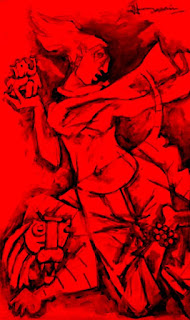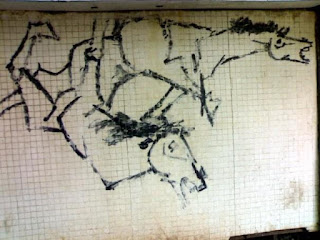There’s something about Maqbool Fida Husain’s style of art that captured my imagination in the early 2000s. Just after I graduated from college. Maybe it was the hype around his Gajagamini movie starring his muse Madhuri Dixit or the protests of the saffron parties that eventually drove him to exile. It was the time when the internet was becoming more accessible and I remember spending hours trying to find his painting online. I had the fortune of seeing a huge red painting on a wall (actually overflowing onto the ceiling) in the residence of Naresh Kumar (former India tennis player) in Middleton Mansions. I believe Hussain used to stay at Mr. Kumar’s residence when he was in Calcutta. I don’t remember why I had dropped into Me. Kumar’s residence - maybe I was with my friend Uday Jhala dropping off something for his mum. Anyway, the passing glimpse of the painting was enough to trigger off an obsessive search for more. The painting I saw was something similar to this one but I can’t be sanguine as it was nearly 2 decades back, and bear in mind I saw it only for a few fleeting moments.
MF Husain had a charismatic, unapologetic personality (he went barefooted all the time(?), he found a muse in Madhuri Dixit) with a distinct, pioneering style of painting. His artwork had simple elegant lines that even a layman like me could appreciate. Sometimes art can be pretentious but Husain’s works were engaging and seemed accessible to the common person not just the highbrow art connoisseur. They looked simple but if you tried copying them, you realised it was quite a challenge. I know, I tried. So I did the next best thing. The Times of India published a Husain painting of Mother India and I got it laminated, it still is in my old bedroom in Kolkata. I think it was similar to this sketch below:
My favourite Hussain story is however about his patronage of Azad Hind Dhaba on Ballygunge Circular Road. I love the Chicken Bharta, Egg Tarka and Rumali Roti from Azad Hind to this day.
I remember walking in this one time on Republic Day 2009, and recognising the painting at the Dhaba. I managed to click a photograph of this sign (above) but I was so busy with collecting my order, that I didn’t stop to ask how a humble Dhaba had a Husain on its wall and this note.
Internet research revealed the the fascinating back story:
The memory of seeing M.F. Husain colouring one of his sketches back in 1999 is still fresh in the mind of the owners of Azad Hind Dhaba, a popular eatery in south Kolkata.
“He was very close to my father Chamanlal Sharma, ever since he first dropped by for tea some 25-30 years ago,” recollected Dharam Bir Sharma (pictured above) one of the partners of Azad Hind Dhaba. “After that he’d drop by every day when he stayed in Calcutta for a chat with my father. One day, he said a portion of the wall should be cleaned for him to paint on it.”
That was in 1996. The wall was cleaned and a black-and-white sketch done by the master in two hours. That was the turning point for the dhaba that grew from a small roadside address to a 40-seater eatery. “Yes, that made a huge difference to the footfall. Dhabas were not as popular back then but people started flocking to see the painting,” recalled Sharma.
The next masterstroke came in 1999 when Husain returned to colour the sketch and modify parts of the painting. He changed “the horse to an elephant” and rubbed out a line from a song he had scribbled to replace it with the words Gaja Gamini.
The now-famous painting, titled Gaja Gamini (one with a walk like an elephant), depicts a dancing woman, in a bright red background, while a white elephant looks on with its trunk held aloft. Mr. Husain arranged a private show of his film Gaja Gamini at Azad Hind in 1999.
Sitting at the cash counter with the painting behind him, Mr. Sharma fondly recalled his memories of the famous artist. He remembers Mr. Husain as a “moody and humble person” who would come to the restaurant and sit quietly in one corner sipping his favourite “kadak chai [strong tea].” A special chai with “less milk and sugar, lots of ginger and a little bit of cardamom in a big bhaar”, and a tandoori roti with chicken reshmi kebab. That used to be the sip-and-bite preference of Azad Hind Dhaba’s most prized patron.
“He did not talk much. But sometimes told me what kind of food he wants,” Mr. Sharma said. He was initially apprehensive of talking to an artist of Mr. Husain’s calibre, but eventually they became friends. “Mr. Husain could mingle with adults and children with equal ease. He was totally devoid of arrogance.” Whenever schoolchildren spotted him at the eatery, they flocked to him and asked for autographs. The world-famous painter complied with their demands with a smile and even drew them impromptu sketches.
On a personal note, Sharma recalled how Husain had designed his wedding card. “It was in 2001, when I called to tell him that I was getting married and he told me he wanted to design my wedding card…. he sent across the design of a groom on horseback.”
Ashok Das, who has been associated with Husain's favourite eatery in Kolkata for about two decades, remembered fondly, “He didn't demand much. He just wanted a copy of an Urdu newspaper and a cup of tea ready. He was very easily satisfied. He first came and made an impromptu black and white sketch on our wall in 1996. Then during the release of Gajagamini, he made some modifications. A big party was thrown here, it was attended by the likes of Mrinal Sen.”
The last time Husain made it to the dhaba was in 2006. The man who drove him there was Bhola Singh (pictured above), chauffeur to Naresh and Sunita Kumar, with whom Husain would often stay during his visits. “Around 30 years ago, Husain saab wanted to have some nice tea and he just couldn’t find the kind he liked. So I took him to Azad Hind Dhaba which was more popular among taxi-drivers back then,” recalled Bhola. Saddened at the news of the artist’s death (2011 in exile in London), the man at the wheel added: “I wish people had not driven him out of the country. He was a good man.”
The dhaba’s way of saying thank you to perhaps its most famous patron was to add Husain’s Special Chicken to the menu — a boneless chicken dish. A patron who painted his signature mural on the dhaba wall and gave the Ballygunge Circular Road address a pen — or rather paintbrush — name: “MF Husain’s Dhaba”.
Sources:
http://www.kolkatafirst.in/?p=991
http://archive.indianexpress.com/news/azad-hind-dhaba-husain-s-favourite-haunt/801672/








